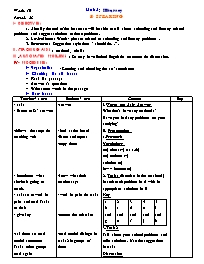Bài soạn môn học Tiếng Anh 11 - Period 28 - Unit 5: Illiteracy B - Speaking

I- objectives:
1. Aim:By the end of the lesson sts will be able to talk about schooling and literacy related problems and suggest solutions to these problems.
2. Lexical items: Words/ phrases related to schooling and literacy problems .
3. Structures: Suggestion style form " should do ".
II. Teaching aids: textbook, chalks
III. Anticipated problems: Sts may have limited linguistic resources for discussion.
IV- Procedures:
1- Organization: - Greeting and checking the sts’ attendance
2- Checking the old lesson:
* Read the passage
* Answer t’s questions
* Write some words in the passage
3- New lesson
Bạn đang xem tài liệu "Bài soạn môn học Tiếng Anh 11 - Period 28 - Unit 5: Illiteracy B - Speaking", để tải tài liệu gốc về máy bạn click vào nút DOWNLOAD ở trên
Week: 10 Unit 5: Illiteracy Period: 28 B- Speaking I- objectives: 1. Aim:By the end of the lesson sts will be able to talk about schooling and literacy related problems and suggest solutions to these problems. 2. Lexical items: Words/ phrases related to schooling and literacy problems . 3. Structures: Suggestion style form " should do". II. Teaching aids: textbook, chalks III. Anticipated problems: Sts may have limited linguistic resources for discussion. IV- Procedures: 1- Organization: - Greeting and checking the sts’ attendance 2- Checking the old lesson: * Read the passage * Answer t’s questions * Write some words in the passage 3- New lesson Teacher’ s acts Students’ acts Content Sup - asks - listens to Ss’ answers -follows the steps for teaching vob - introduces what she/he is going to teach. - asks sts to work in pairs and read Task1 to do it - give key -ask three sts read model sentences Task1 other groups read again - asks sts to work in groups - gives suggested useful expressions on the board. -asks sts to tell problems and solutions of their school. - asks sts to use the information of Task 1. - goes around and helps sts. - calls some groups to practise speaking in front of the class -asks sts to continue to work in groups again. -T asks them to give problems and solutions in their class. - gives them some words - asks them to practise. - -calls some groups to retell their ideas - checks sts’ pronunciation -Write the homework on the board -answer - look at the board -listen and repeat -copy them -know what their teacher says - work in pairs do task1 -correct the mistakes -read model dialoge in tasks2 in groups of three - work in groups of three - can use suggested useful expression -Tell some problems and solutions of their school. -sts pratise speaking and use the information of task 1, teacher’s giving. - re-speak in front of the class -work in groups again -think some ideas about problems and solutions of their class -practise speaking with suggested model sentences (conservation) - go in front of the class and retell - correct the mistakes -Do it at home I. Warm up: Ask- Answer Who don’t have any textbooks? Have you had any problems on your studying? II. Presentation 1.Pre-teach Vocabulary (to) cheat (v) (at s.th) (to) enforce (v) solution (n) low – income (n) 2. Task 1(Exercise in the text book) Match each problem in A with its appropriate solutions in B Key 1 b and g 2 a and e 3 d and f 4 c and j 5 i and h 3.Task 2 Talk about your school problems and offer solutions. Use the suggestions in task1 Discussion Think about some school problems and then give some solutions. *Useful expressions -Have you thought about .? -What can be done to solve this problem? -How about .?/ what about ? -It might be a good idea to -I think we should -Problems in school (in colum A – Task 1) - Offering solutions (in columB Task1) Model 1. Example: in the text book Task 3 Think of three or four problems your class is experiencing, Talk about them and offer solutions. You may use the cues below Suggested words -make too much noise -forget doing homework Model A: What do you think about our class size? Over 50 students so it’s difficult for teachers to help each of us B.Yes, but we don’t have enough teachers and classrooms. C.So what our school has to do is to have more teachers and have more rooms built III. Homework Practise speaking more time at home
Tài liệu đính kèm:
 Av11(T28).doc
Av11(T28).doc





